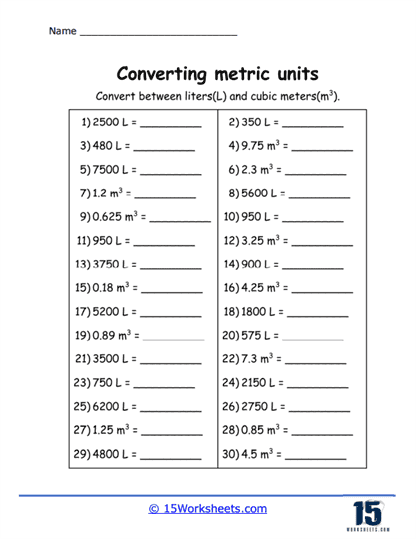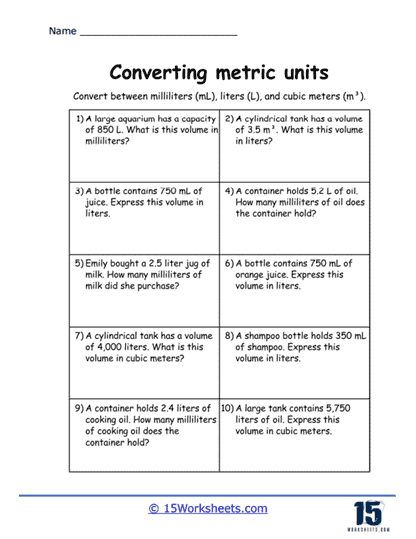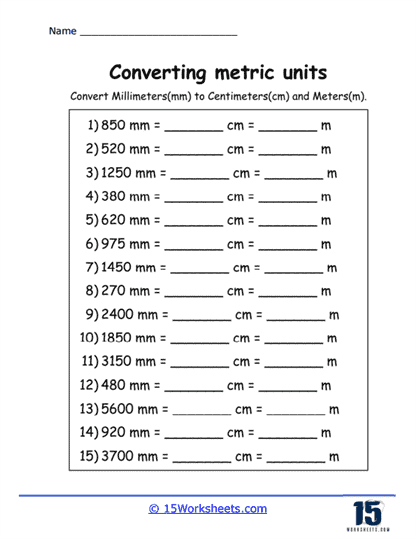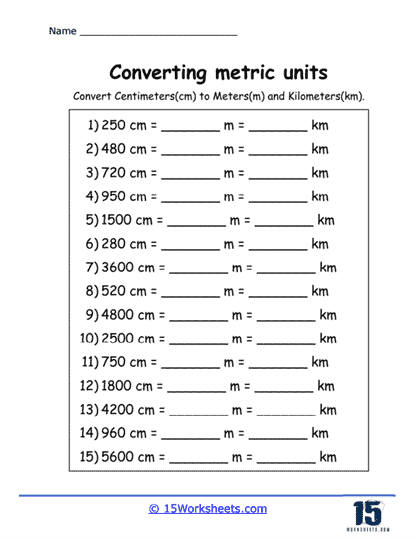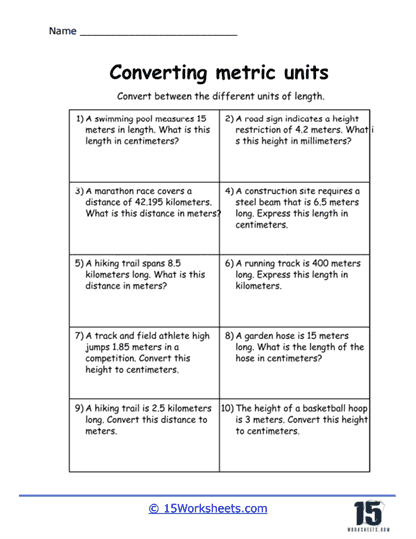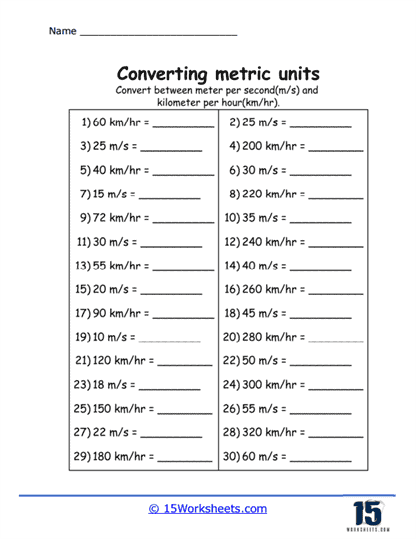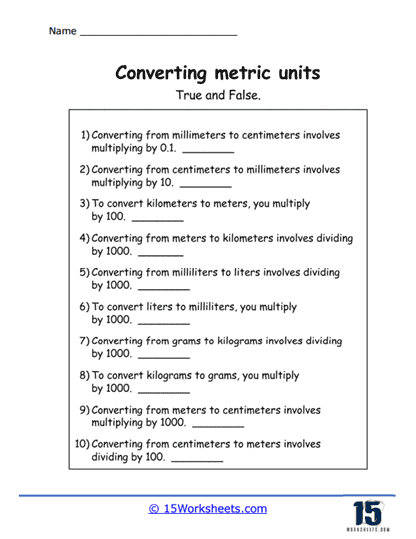Converting Metric Units Worksheets
About These 15 Worksheets
These worksheets will help students understand and master the process of converting between different metric units. These worksheets are essential in mathematics and science education, where a solid grasp of the metric system is crucial. The metric system, predominantly used worldwide, is a decimal-based system of measurement that includes units such as meters, liters, and grams. These worksheets train students in the practical application of these units through a variety of exercises that challenge their ability to manipulate and convert these measurements effectively.
Through a diverse array of exercises-from simple conversions to complex application problems-these worksheets equip students with the mathematical proficiency necessary to navigate both academic challenges and real-world tasks. By mastering these skills, students enhance their mathematical literacy and prepare themselves for further studies in various scientific fields.
The foundation of a converting metric units worksheet often begins with an introduction to the basic units of the metric system. This section explains the primary units of length (meter), volume (liter), and mass (gram), along with their multiples and submultiples that are derived by scaling by powers of ten. Students learn the prefixes like kilo-, centi-, and milli-, which are used to denote larger or smaller quantities. For example, a kilometer is 1000 meters, while a milligram is one-thousandth of a gram.
One of the most common types of exercises on these worksheets involves straightforward conversion questions. Students are given a specific measurement and asked to convert it into another unit within the same category. For example, converting centimeters to meters, grams to kilograms, or liters to milliliters. These exercises require students to multiply or divide the quantities by factors of ten, reinforcing their understanding of the decimal nature of the metric system.
Conversion Tables – Conversion tables are a staple in these worksheets. They typically present a list of values in one metric unit alongside empty slots for the corresponding values in another unit. Students fill in the missing values, practicing the process repeatedly. This exercise solidifies memory of the conversion factors and aids in quicker mental conversions. Some worksheets introduce cross-multiplication to convert units that do not directly scale by a factor of ten. For example, converting meters per second to kilometers per hour involves multiplying by conversion factors for both the distance and time components. These exercises are particularly useful in preparing students for more advanced topics in physics and engineering.
Matching and Sorting Activities – To engage younger students or to diversify the methods of learning, worksheets may include matching or sorting activities. These could involve matching pairs of equivalent measurements or sorting a series of measurements into ascending or descending order based on their value in a single unit. Such exercises make learning conversions interactive and can serve as a quick assessment tool for teachers. Worksheets may also feature puzzles where students must use conversions to unlock the answer to a riddle or complete a crossword puzzle. Each clue might involve a conversion that leads to discovering a letter or number key to solving the puzzle. These are engaging ways to encourage problem-solving and ensure that the metric system becomes a familiar tool for students.
Mixed Unit Conversions – For more advanced students, worksheets might include exercises that require conversions across different types of units, such as converting speed (meters per second to kilometers per hour) or energy (joules to kilojoules). These require an understanding of how different physical quantities are interrelated and often involve compound conversions.
Diagram-Based Questions – Visual learners benefit from diagram-based questions, where they might have to use a diagram of a measuring cup or a ruler marked in centimeters and millimeters to answer questions. This type of question helps students visualize measurements and understand dimensions in a tangible way. Finally, advanced converting metric units worksheets might incorporate scenarios from science and engineering to demonstrate the relevance of metric conversions in professional contexts. These could include calculating dosages in medicine, adjusting recipes in culinary arts, or scaling blueprints in engineering tasks.
When Do We Use These Skills?
Conversion between various metric units of measurement is a fundamental aspect of daily life, education, and professional practices across a range of fields. The metric system is an international decimalized system of measurement that is used almost universally across the world, making understanding these conversions crucial for communication, trade, scientific research, and technology development.
Everyday Practical Uses
In everyday life, the need to convert metric units arises frequently in numerous contexts:
Cooking and Baking – Recipes often specify ingredients in grams, milliliters, or liters, but kitchen measuring tools might only be marked in different units. For example, a European recipe might require 500 grams of flour, but an American might need to convert that measurement to cups based on a conversion table.
Shopping – When buying fabric, liquids, or bulk food items, you might need to understand conversions between units like meters and centimeters or liters and milliliters to make informed purchases according to your needs.
Travel – Understanding different metric units is essential, especially when dealing with speed limits (km/h) or fuel efficiency (liters per 100 kilometers) in countries that use the metric system.
Home Projects – DIY projects, such as carpentry or gardening, often require precise measurements. Converting between units like millimeters, centimeters, and meters can be crucial for the accuracy of building materials or spacing of plantings.
Scientific Research and Healthcare
The uniformity of the metric system in scientific research is crucial for standardization, replication, and dissemination of findings:
Data Collection and Analysis – Researchers often collect data in one metric unit and need to convert it to another to align with scientific standards or journal requirements.
Collaboration – Scientists working internationally rely on the metric system for seamless collaboration. Conversions ensure that measurements are accurately communicated without errors that could result from unit discrepancies.
Dosage Calculations – Medications are typically prescribed in milligrams or grams, but may need to be administered in different volumes. Nurses and pharmacists must convert these units accurately to ensure patient safety.
Medical Measurements – Patient data such as weight, height, and volume of fluids are often collected in different units depending on the equipment used, requiring conversions for diagnosis or treatment plans.
Global Commerce
In global trade, products, and services are often produced in one country and sold in another, necessitating conversions between metric units for pricing, packaging, regulations, and compliance:
Import/Export – Goods sold internationally must have their weights, volumes, and dimensions converted to the metric units familiar to the trading partners.
Regulatory Compliance – Many products must meet specific size or capacity regulations that are country-specific and often stated in different metric units.
Material Specifications – Engineers and architects often work with materials that are specified in a variety of metric units. Conversions are necessary to ensure that all measurements comply with design specifications and regulatory requirements.
Interdisciplinary Communication – Different engineering disciplines may use different units for the same parameters. For instance, a mechanical engineer and a civil engineer might need to communicate about pressure or force in different units like kilopascals or megapascals.








